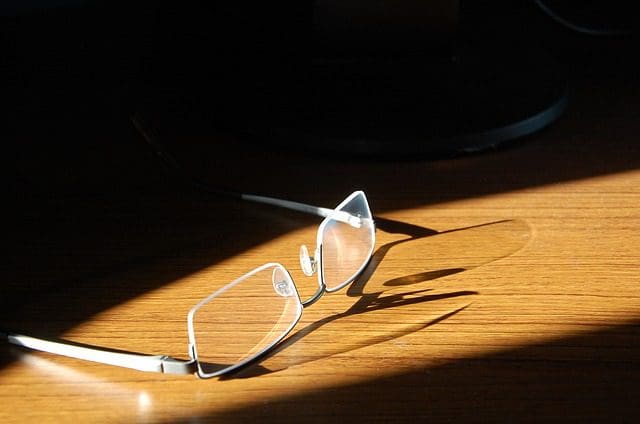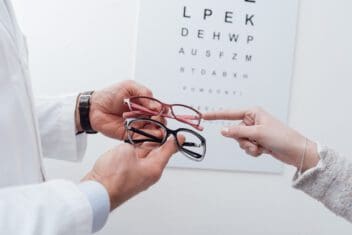Understanding Eye Refraction: What It Is & If You Need It
Home / Vision Education Center /
Last Updated:
Eye refraction is the calculation of the lens power required for eyeglasses or contact lenses, determined through a refraction test. These tests are essential for diagnosing refractive errors that affect how light bends through the eye’s lens, leading to distorted visual perception, a common problem for over 150 million people in the U.S. Regular refraction testing can help in early detection of various eye conditions and determine the need for vision correction.
Table of Contents
Eye refraction is how the power of eyeglasses or contact lenses is calculated. This measurement is based on how much the lens of the eye has to bend light rays to process visual stimuli. This is expressed in a measurement of distance and clarity.
More than 150 million people in the U.S. have a refractive error, according to the National Eye Institute. When you have this defect, your eye cannot focus images clearly on the retina. As a result, objects that are too far or near appear blurry.
Refraction tests can also detect other eye problems as well as the likelihood that people will need vision correction. Everyone should have refraction testing.
People near the age of 60 or over should be tested every year, while those younger can be tested every other year. Eye testing like this is widely available through private practice, and it is generally covered by vision insurance plans. It can also be available through state-funded programs for low-income residents as well as through nonprofits and charities.

What Is Eye Refraction?
Eye refraction is the measurement of the required power for a person’s eyeglasses or contact lenses. This is calculated by means of a refraction test (also known as a vision test), typically conducted as part of a standard eye examination. A refraction test gives a doctor the precise measurement for a prescription that a patient will need for their glasses or contact lenses.
The American Optometric Association explains that perfect vision is often expressed as 20/20 vision, which means a person can see clearly at 20 feet what they normally should be able to see 20 feet away. On the other hand, 20/100 vision means that a person would have to be 20 feet away to be able to see what a person with “normal” vision can see from 100 feet away.
You deserve clear vision. We can help.
With 135+ locations and over 2.5 million procedures performed, our board-certified eye surgeons deliver results you can trust.
Your journey to better vision starts here.
These measurements are calculated by refraction tests.
20/20 Vision
People who do not have 20/20 vision will have a refractive error, which means that light rays are not bending as they should when they pass through the lens of the eye. This causes distortions with how visual stimuli are perceived. According to the National Eye Institute, this is the most common form of vision problem, affecting over 150 million people in America. It explains why so many people need glasses, contact lenses, or other forms of vision correction.
A vision test will measure the amount of bending, providing the doctor with the required information to prescribe appropriate lenses to the patient.
What Happens in a Refractive Eye Exam?
During an exam to test for refractive errors, your optometrist or ophthalmologist may conduct several tests to pinpoint the type of error that you have. Doctors prefer one or both of two standard tests—the visual acuity test and the retinoscopy exam.
Visual Acuity
Visual acuity measures how well each eye can see and focus. This test requires the patient to read letters on a chart placed 20 feet away, starting from the top row and with one eye closed at a time.
The rows (letters) get smaller down the chart, and the last one you’re able to read clearly indicates your level of vision clarity.
A positive refractive error diagnosis is confirmed if you can’t see the letters or symbols on line 20/20, which indicates normal visual acuity.
Retinoscopy
Retinoscopy involves the use of a hand-held instrument called retinoscope to narrow down the diagnosis to farsightedness, nearsightedness, or astigmatism. Before beginning this procedure, your optometrist may dilate your eyes to improve the accuracy of the test.
While moving the retinoscope light horizontally and vertically across each eye, the specialist observes reflection patterns off the retina. This test enables them to determine your exact type of refractive error.
Your optometrist may ask you to look at an object or chart through a phoropter to precisely assess the exact visual correction each eye needs. This device changes multiple lenses of varying power in front of your eyes.
Test results get evaluated, usually within a few minutes, to determine the best treatment plan to correct your eyesight. You can discuss potential remedies with your optometrist, such as glasses or contact lenses.
What Can a Test Find?

An eye refraction test not only tells a doctor if a patient needs corrective lenses (and what power the lenses have to be), it also tells a doctor if the patient has a number of conditions, such as:
- Astigmatism (a refractive issue based on the shape of the lens of the eye, which can cause blurry vision).
- Hyperopia (farsightedness).
- Myopia (nearsightedness).
- Presbyopia (inability of the lens of the eye to focus, related to changes in the structure of the eye due to aging).
Additionally, the results of the test can help diagnose:
- Retinal vessel occlusion (a condition that blocks the small blood vessels near the retina).
- Macular degeneration (an aging-related condition that affects central vision).
- Retinal detachment (when the retina becomes detached from the rest of the eye).
- Retinitis pigmentosa (a genetic condition causing retinal damage).
You deserve clear vision. We can help.
With 135+ locations and over 2.5 million procedures performed, our board-certified eye surgeons deliver results you can trust.
Your journey to better vision starts here.
Who Should Have Tests?
Refraction tests should be conducted regularly. People under the age of 60, who are healthy and have no outstanding vision problems, should receive a test every two years. When a child turns 3 years old, they should have a refraction test every year or every other year.
A person who wears corrective lenses (eyeglasses or contacts) should take a vision test every one to two years. Eyes change, and regular testing helps a doctor learn if a new prescription is necessary instead of a patient using corrective lenses that no longer offer adequate vision improvement. A patient who has vision problems between their tests should schedule another test rather than waiting for the next planned test.
Where to Get a Refractive Eye Exam
Seek out a refraction eye test if you have trouble seeing objects from a distance or from close up, such as text in a book. You can visit your optometrist to get a proper diagnosis and glass or contact lens prescription.
An ophthalmologist’s office should also have the diagnostic equipment for myopia, hyperopia, hypermetropia and other refractive errors. You can see them or take your child to them for a comprehensive eye exam or a single test.
Most local eye doctors can help you. If they can’t, they likely can refer you to a colleague who can.
Elderly Patients & Those With Diabetes
A patient who has diabetes should have an eye test every year. Diabetes is associated with a range of eye conditions, such as glaucoma and diabetic retinopathy.

Glaucoma is a condition that occurs when there is too much pressure accumulating in the eye, resulting in damage to the optic nerve and the retina. The American Diabetes Association warns that people who have diabetes have a greater risk for blindness than people in the general population, so regular testing for this group is essential.
People over the age of 60, or who have a family history of glaucoma and other eye conditions, should get a yearly refraction test. Regular exams will alert a doctor to the buildup of pressure in the eye, so they can initiate treatment early.
Light Refraction & the Eye Chart
Since refraction is the measurement of how light rays bend when they enter the lens of the eye, a refraction test looks at the degree to which light bends as it moves through the cornea and the lens. Some doctors just shine a light into the patients’ eyes, examining how much light bounces off the retina. They then calculate the refractive score based on this observation. Others might use a computer, which does the calculations.
With this score, the doctor will determine the exact prescription required. This is done by placing the patient in front of a device known as a refractor or phoropter. A refractor looks like a big mask with dozens of lenses that fits over the patient’s head. About 20 feet in front of the patient will be the famous chart of letters (officially known as the Snellen Eye Chart, first developed in 1862) with varying sizes on every line.
Testing one eye at a time, the doctor will ask the patient to read the smallest row of letters they can make out, changing out the lenses on the refractor to find the best fit for the patient. When one eye is tested, the procedure is repeated on the other eye. This process gives the doctor the necessary information to prescribe lenses that will give the patient 20/20 vision.
Paying for Refraction Tests
Everyone should get a refraction test, even if they have otherwise healthy eyes. As a person ages, the structure and functioning of their eyes change. Regular vision testing will help them prepare for a gradual loss of vision that comes with age.
Refraction testing will also alert doctors to the presence or development of changes in the eyes that are the result of certain diseases or conditions. Various eye diseases may not show apparent symptoms in the individual until they have caused significant damage. Doctors can detect early signs of these conditions in standard eye exams, resulting in a much earlier diagnosis and prompt treatment that can preserve vision to the maximum extent.
Refraction tests are a routine part of a visit to an eye doctor, and they require no preparation from the patient. A test can be as little as $50. Even in places where the tests are more expensive, a checkup every other year can save a lot of money in future expenses to correct vision.

NerdWallet also notes that most refraction tests are typically covered by vision insurance, which is distinct from health insurance. Most health insurance companies will cover vision-based medical care if the problems are detected in a refraction test. For example, treatment of cataracts, age-related macular degeneration, and glaucoma are covered by most standard health insurance plans.
There is a good possibility that all or part of a patient’s eye exams will be covered by a standard vision insurance plan. Contact your vision insurance provider to confirm the specifics of your particular plan.
In addition, many state governments, nonprofit organizations, and charities will have options for low-income residents to receive free eye care, which includes basic refraction testing.
You deserve clear vision. We can help.
With 135+ locations and over 2.5 million procedures performed, our board-certified eye surgeons deliver results you can trust.
Your journey to better vision starts here.
References
- Visual Acuity: What Is 20/20 Vision? American Optometric Association.
- Refractive Errors. (July 2019). National Eye Institute.
- Medical Definition of Refraction Test. MedicineNet.
- Do You Need a Refraction During Your Eye Exam? (November 2015). Angie’s List.
- Eye Exams for People With Diabetes. American Diabetes Association.
- Eye Complications. American Diabetes Association.
- What Is a Phoropter? (September 2018). WebMD.
- Snellen Eye Chart for Testing Vision. (January 2020). Verywell Health.
- Common Age-Related Eye Problems. (March 2015). Cleveland Clinic.
- Eye Glasses for Those in Need. Catholic Charities of Southwest Kansas.
- Optometrist or Ophthalmologist: Which Is Best for Your Eye Care? (June 2017). Cleveland Clinic.
- Keep an Eye on Your Vision Health. (July 2018). Centers for Disease Control and Prevention.
- How to Detect Myopia in the Eye Clinic. Community Eye Health. Date Fetched: July 28, 2021.
- Myopia (Nearsightedness). American Optometric Association. Date Fetched: July 28, 2021.
This content is for informational purposes only. It may have been reviewed by a licensed physician, but is not intended to serve as a substitute for professional medical advice. Always consult your healthcare provider with any health concerns. For more, read our Privacy Policy and Editorial Policy.
